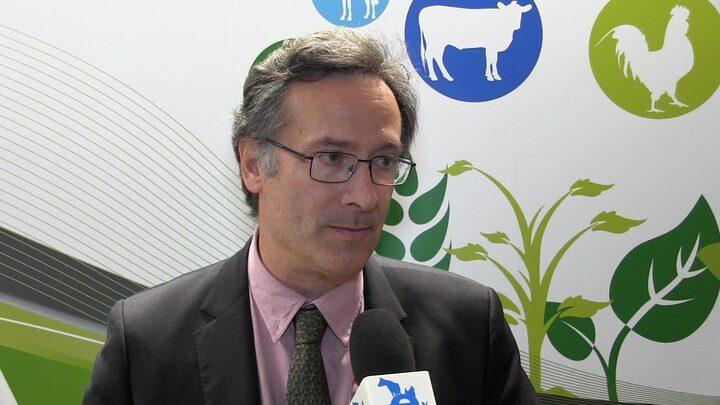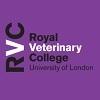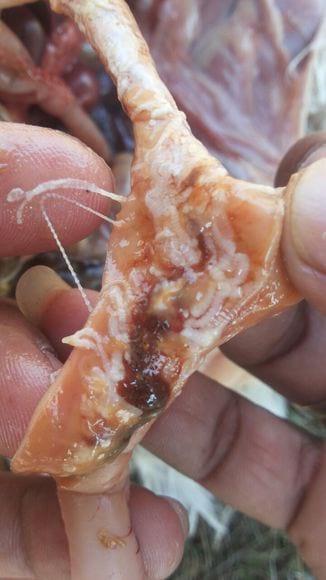Explore all the information on
Parasitic diseases in poultry
A parasite is an organism that lives in or on another organism (referred to as the host) and gains an advantage at the expense of that organism. The two types of internal parasites that affect poultry are worms and protozoa. Usually, low levels of infestation do not cause a problem and can be left untreated. Clinical signs of a parasite infestation include unthriftiness, poor growth and feed conversion, decreased egg production, and, in severe cases, death. Also, parasites can make a flock more susceptible to diseases or worsen a current disease condition. External parasites can also cause problems for small flock poultry producers and occasionally for large flock producers. These unwanted visitors can be brought into the poultry house by wild birds or new birds being added to the flock. All new birds should be checked for parasites before they are mixed with the original flock.
In recent years, in response to consumer concerns regarding welfare of birds, there has been a move from caged to free-range production systems. This change has resulted in increased exposure of hens to pathogens, including parasites, which can compromise the welfare of the animal (Wongrak et al., 2015). Amongst helminths, Ascaridia galli is the most abundant nematode in poultry, and can cause significant economic losses and negative impacts on bird health and welfare (Daş et al.,...
Comments : 0
Recommendations: 0
In poultry farming, worms and protozoa represent the two primary classes of internal parasites that impact bird health, welfare, and productivity. While indoor-reared poultry typically avoid infestation from worms that require intermediate hosts, free-range birds are more susceptible. Interestingly, broilers tend to...
Comments : 0
Recommendations: 0
This issue will cover: -What are behavioral needs? -What is dustbathing? -Dustbathing in commercial housing systems Substrate...
Comments : 0
Recommendations: 0
A recent study suggests that artificial Ascardia galli infection has no effect on performance and egg quality of free-range laying hens from the point of lay until 40 weeks of age (Sharma et al., 2017). However, the lower hepatic lipid reserve of infected hens observed in the same study indicated the potential for A. galli to affect production at a later stage. In this study, serum and yolk antibody levels of A. galli were measured to investigate the immune response to natural infection in...
Comments : 0
Recommendations: 0
Vijay Durairaj (Huvepharma) discusses lesions, PCR sequencing, and vaccination strategy in this Engormix interview during IPPE 2025 in Atlanta, USA....
Comments : 0
Recommendations: 0
1. Introduction Avian coccidiosis, caused by Eimeria spp., is one of the vulnerable enteric diseases and is endemic in vast areas of the tropical and subtropical regions [1]. It reduces growth performance affecting chicken meat production and accounts for about 30% of the total expenses on medications and other pharmacological products used to control poultry diseases [2]. Out of seven recognized species, E. acervulina, E. necatrix , and E. tenella cause...
Comments : 0
Recommendations: 0
Dr. Christiane Keppler, Landesbetrieb Landwirtschaft Hessen (LLH - Hesse State Framing Authority)
As in previous years, poultry farmers are currently facing a number of challenges. These include, in particular, a further...
Comments : 0
Recommendations: 0
Hector Salgado (Jefo Nutrition) presents his poster on alternatives to traditional anticoccidials, during the Symposium on Gut Health in St. Louis, USA....
Comments : 1
Recommendations: 1
Introduction Coccidiosis is a parasitic infection caused by Eimeria spp and persistently affecting broiler chicken, causing high morbidity, impaired growth, and mortality [1]. Unlike many other protozoan parasites, Eimeria spp exclusively invades the intestinal epithelium showing high tissue specificity [2]. Eimeria (E.) maxima is characterized by producing the largest oocysts and male gamonts among the other species infecting chicken [3]. E. maxima particularly infects chickens at...
Comments : 0
Recommendations: 1
Introduction Heat stress (HS) is one of the most challenging environmental stressors despite the modern climate control equipment in broiler chickens’ houses. Broiler flocks may be seasonally exposed to HS that varies in intensity according to the relative humidity of the region [1]. Multiple studies have identified the various adverse effects of acute or chronic HS on chickens, such as a severe reduction in feed intake and growth [2–4], systemic alkalosis [5],...
Comments : 0
Recommendations: 1


Sustainability as a Non-Negotiable Pillar in Modern Poultry Production
Suggested link
Histomonas meleagridis and Escherichia coli exhibit an outstanding interplay in vitro and are well recognized pathogens in poultry causing histomonosis and colibacillosis, respectively. H. meleagridis and E. coli reside in the intestine of birds, thus, to understand their interaction in vivo, gut microbial changes and caecal wall penetration of E. coli were investigated separately in experimentally infected chickens and turkeys (Abdelhamid et al., 2020, 2021). In the first trial, commercial...
Comments : 0
Recommendations: 0
Coccidiosis is a disease with substantial economic impact (Muthamilselvan et al., 2016), particularly due to the push to ban anticoccidials. Vaccines are available but can be expensive, and are often implemented for free range and breeder flocks only. Thus, it is imperative to find effective nutritional alternatives to reduce the impact of coccidiosis on broiler chickens. The aim of this experiment was to determine if the nutritional strategies of post-pellet whole wheat (WW),...
Comments : 0
Recommendations: 1
I. INTRODUCTION Consumer demand for organic and free-range poultry products is driving the commercial egg industry away from conventional housing systems towards free-range housing systems that allow birds access to the outdoors. Whilst these systems are considered higher welfare, they also carry more health risks that can impact the intestinal health of the bird, such as greater exposure to parasites as reported by Permin et al., (1999). Intestinal helminths such as nematodes and...
Comments : 0
Recommendations: 1
Vijay Durairaj (Huvepharma) Turkey coccidiosis is caused by Eimeria species. Seven Eimeria species are recognized in turkeys of which three are considered highly pathogenic and predominant. Objective: The objective of this presentation is to provide an overview of the pathological lesions of turkey coccidiosis for field vets, techs, supervisors, and turkey growers. Application of advanced molecular diagnostic tools, such as PCR and...
Comments : 1
Recommendations: 0
.jpg&w=3840&q=75)

Introducing Afla-V ONE: Safe, Sustainable Aflatoxin Detection for Complete Feeds and Pet Foods
Suggested link
Vijay Durairaj (Huvepharma) provides an overview of the pathological lesions of turkey coccidiosis, and comments on the application of advanced molecular diagnostic tools, such as PCR and sequencing, in this interview during IPPE 2024 in Atlanta, USA....
Comments : 0
Recommendations: 0
Dr. Damer Blake (Royal Veterinary College) explains his recent findings on this parasite and how to control the damage that it causes, during the 5th IHSIG Symposium on Poultry Intestinal Health in Bangkok, Thailand....
Comments : 1
Recommendations: 2
The common bed bug (Latin name Cimex lectularius) is part of a group of blood-feeding parasites called Cimicids. The common bed bug was mostly eradicated in North America in the 1960s. Then, in the 1990s, large cities such as New York, Chicago, Cincinnati, Toronto, Montreal and Winnipeg saw a rise in bed bug infestations that spread throughout the U.S....
Comments : 1
Recommendations: 1
We can see tapeworm infestation in backyard poultry, layer chicken as well as in breeder chickens too but due to short life cycle of culling in commercial broilers i.e. around 40 days, it’s difficult to found tapeworms in broiler birds.
Apart from that, in rainy season due to poor litter management & favorable conditions for growing of intermediate hosts like ant, beetles, snails & slugs etc, many broiler...
Comments : 0
Recommendations: 2


Speculation over the Provisional Ruling on Anti-dumping Duties of Lysine by the EU Against China
Suggested link
Introduction Coccidiosis causes a great economic loss in the poultry industry due to high rate of morbidity and mortality, sub optimal growth and conversion efficiency and loss of egg production (1). Mortality is mostly marked in caecal form of the disease in young chicks whereas morbidity is well documented in the intestinal form of the disease in adult birds. Etiology The disease is caused by a protozoan parasite known...
Comments : 92
Recommendations: 1
With the growing popularity of free range production systems, the incidence of helminth infections has increased in commercial poultry farms in Australia. Adequate control can only be maintained by regular application of commercial anthelmintics. Until very recently, levamisole (LEV) and piperazine (PIP) were the only registered chemicals to treat nematode infections in chickens with no published appraisal of their efficacy status since registration. We report the first formal investigation...
Comments : 0
Recommendations: 0

















.jpg&w=3840&q=75)














